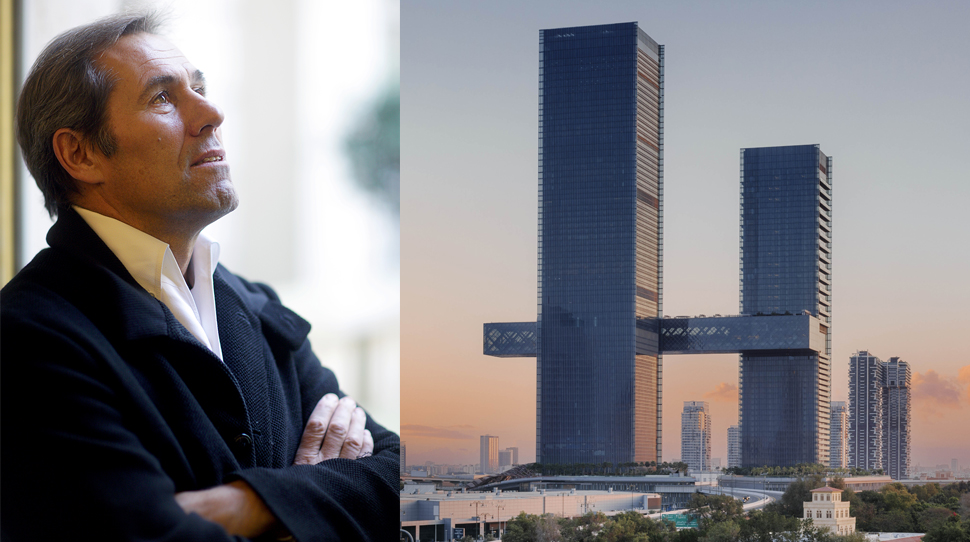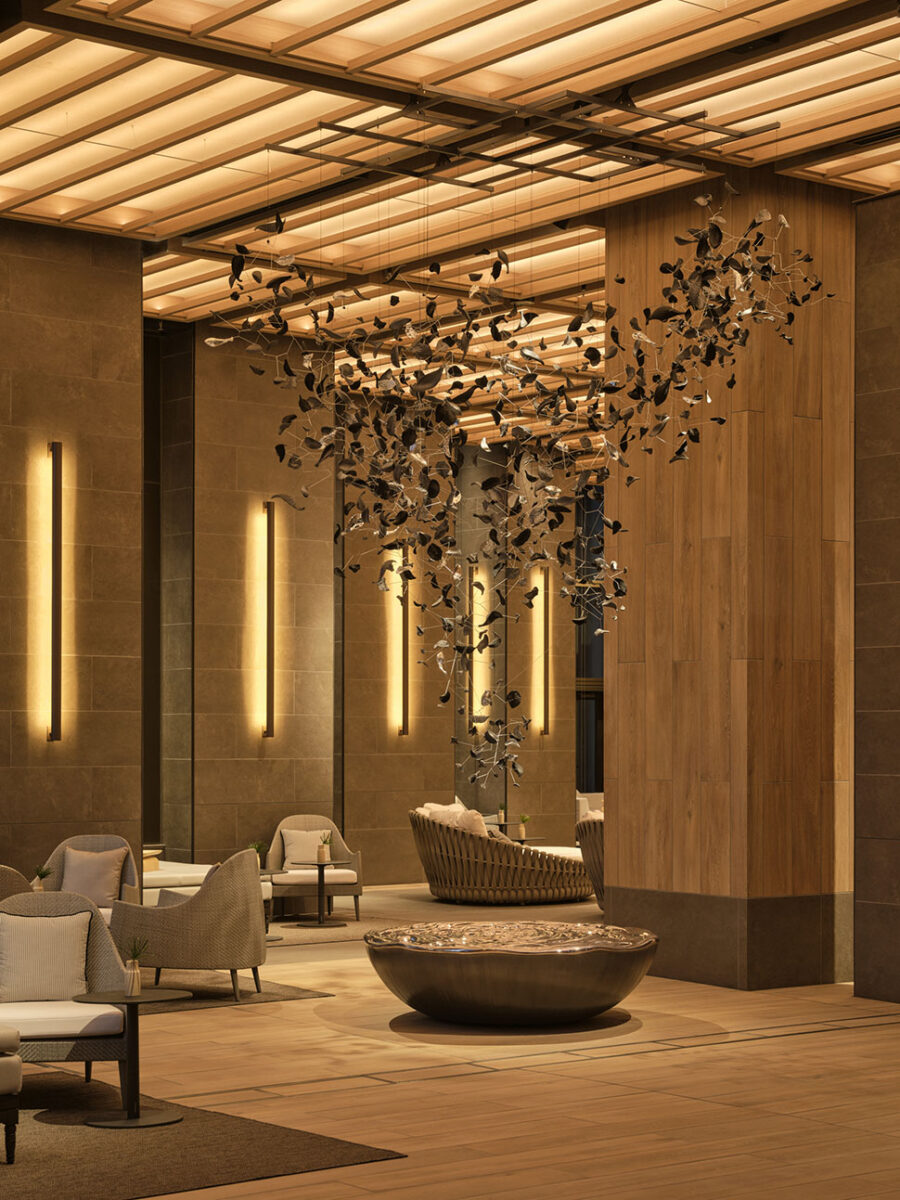

Some of the world’s most stunning hotels, like Four Seasons Hotel Bangkok at Chao Phraya River, Amanyara in Turks and Caicos, Aman New York and Nizuc Resort & Spa in Cancun, came from the mind of Jean-Michel Gathy. But the Belgium-born, Malaysia-based architect’s influence reaches even further — he is credited with setting hotel design trends that have become standard, such as over-the-top pools (like Marina Bay Sands’ iconic 57th-floor outdoor pool), spa-like bathrooms (like The Setai, Miami Beach) and overwater hammocks (like One&Only Reethi Rah in the Maldives).
Gathy and his firm Denniston have had a busy year debuting more beautiful hotels, including One&Only One Za’abeel, an H-shaped building in Dubai with sand-toned interiors, and Janu Tokyo, the first property from Aman’s more youthful but still stylish new sister brand. Aman Nai Lert Bangkok and Cheval Blanc Seychelles will come later in 2024, and Gathy has many more in the works.
The visionary architect took some time out between projects to share where he gets inspiration, his favorite travel destinations and the most memorable hotel feature.

How would you describe your design aesthetic?
I am someone who likes structure in design. I like geometry, and I like it when things make sense. I dislike shapes and forms going in every direction without reason. I want you to feel that there’s an intention behind each direction. Someone once summarized my aesthetic by saying that my design is sometimes dramatic, sometimes intimate, but always charismatic, and I believe that’s the best way to describe it.
What are the hottest trends in hotel design right now?
Hotels have increasingly become lifestyle venues rather than just accommodations. The lifestyle concept varies greatly depending on the location — whether it’s in a city, a lively area, a romantic place, the mountains or by the sea. Therefore, there are many different environments, but the overall trend is toward a more lifestyle-based approach.
What is the future of hotel design?
In my opinion, there will be a trend toward people trying to develop properties with a stronger identity. Most large hotel companies need numbers, resulting in larger hotels such as Hilton, Sheraton, Marriott, etc., which represent one type of product. However, I specialize in the luxury segment of the hotel industry, where everything is about being creative and artistic, which addresses the lifestyle demands of clientele who seek recognition and personalized attention. Therefore, I believe hotels will increasingly cater to specific niches on a one-to-one basis, becoming more bespoke in their offerings.

What’s the one hotel design feature that you think guests remember most?
I would say the bedroom. I believe everything revolves around comfort. A hotel is a place where you are inherently outside of your comfort zone. Therefore, being embraced by an environment that offers comfort is crucial. When you enter a hotel, you immediately sense whether it feels good or not. It’s not about the color scheme — blue, red or yellow — nor about the size or opulence; these are technicalities. It’s the emotional comfort that matters — feeling at ease and welcomed.
Personally, I appreciate hotels with human-scale facilities where you don’t encounter long waits at reception during check-in, which I find inhospitable. For me, a welcoming lobby and a comfortable bedroom are essential. Ultimately, the quality of the mattress and the functionality of the shower are crucial. While I appreciate good views, quietness, comfort and coziness matter most to me, along with a perfectly functioning shower.
Where do you find design inspiration?
I suppose it’s a matter of personality. I’m naturally creative and a romantic guy. I like to layer my designs, and I believe my inspiration primarily comes from my travels and my wife. My wife and I share many ideas, and our discussions have shaped my way of looking at things.
Additionally, being European by birth and education, and having lived in Asia for 44 years, my classic European education has been significantly influenced by my time in Asia. This, combined with extensive travel and my curious personality, amalgamates to form my sources of inspiration.
You’ve designed many hotels for Aman. How does that design philosophy differ from that of new sister brand Janu?
The difference between an Aman and Janu is somewhat akin to the difference between a Mercedes S-Class and an S63 AMG. Both are great cars — comfortable, appealing and discreet. Aman is calmer and more oriented toward relaxation, whereas Janu aims for the same quality and standards but with a livelier and slightly edgier approach in terms of sports and overall facilities. Janu targets a younger audience with a larger number of rooms, around 120 or so, while still maintaining quality control. It is designed to be more lively, edgy and youthful while adhering to the same standards set by Aman.

One&Only One Za’abeel in Dubai is a new architectural wonder. In a city that pushes the boundaries of design, how did you make its interiors stand out?
I have worked on several One&Only properties, like One&Only Reethi Rah and One&Only Montenegro, so we are deeply familiar with the One&Only DNA. The DNA of One&Only is centered around passion, activity, creativity, elegance, comfort and chicness. When applying these core values to a dynamic city like Dubai, known for its edginess, speed and showiness, we focused on capturing the local sense of place. This involved integrating Dubai’s unique characteristics into the established DNA of One&Only.
We used all of these characteristics to create space, glamour, volumes, color and intricate detailing, all while maintaining a lively yet classy and chic atmosphere with high-quality materials. We also incorporated Arabic motifs, lifestyle elements, and philosophy to further enhance the experience, and that is what makes the One&Only Dubai.
What are your top travel destinations?
I have many destinations that I love. I enjoy traveling around the world, and I particularly admire countries that have a strong identity. I love places like Japan, Nepal, Bhutan, Saudi Arabia, Italy, France, Norway, Turkey, Peru, Bolivia and the United States, each offering unique and compelling experiences. Whether it’s exploring the Grand Canyon in the West or Massachusetts in the Northeast, these diverse offerings of a country are particularly attractive to me. Additionally, I have a fondness for Botswana and other parts of Africa, such as Kenya and Morocco.
I find it challenging to choose favorites because I appreciate many places, like the Maldives for one reason and the Seychelles for another — they are both stunning islands, among others.
I’ve been fortunate to travel extensively throughout my life, spending at least 200 days a year abroad. As a result, I do not harbor notions or preconceived ideas about countries. I consider myself a global citizen who believes in a world without borders. It saddens me when borders are used to divide people. I believe that there are beautiful people everywhere in the world and there are also bad people everywhere in the world. But overall, I’ve found that if you smile first, every country is a fabulous place to go.

What are your favorite things to do in Kuala Lumpur, where you live?
One of the greatest things about Kuala Lumpur is actually not what you visit or don’t visit. Of course, the city center is vibrant and located at the foot of a 2,000-meter-high jungle, which creates a fantastic and dramatic setting. But what is truly special about Kuala Lumpur is the people. I can tell you that I don’t know many places in the world where it is so pleasant to live. There’s no arrogance, no attitude and no nonsense. You have a mixture of Malays, who are Muslim; Chinese, who are mostly Buddhist or Christian; and Indians, who are Hindu or Christian.
This mix of races is very attractive because it creates diverse families. There’s always a mixture, like a Chinese person marrying an Indian, an Indian marrying a Malay and so on. This makes people extremely patient with everybody and accustomed to having a mixed-race family.
This makes the city absolutely pleasant. Another one of the particularities, of course, is the food because of these three races I mentioned. You have fantastic offerings in terms of restaurants that are remarkable.
There are also beautiful caves and mountains to visit, as well as dramatic jungle walks. But this is not the main reason for the attraction. The attraction is the people and the food.
What are your carry-on essentials?
A tie, two white shirts, a jacket that isn’t crisp, a coat and of course, my aftershave. For a cold country, I always wear a beret, which is very useful, and sometimes a pair of leather gloves.
I normally have one pair of formal shoes, and most of the time I wear sneakers. But my sneakers are beautiful, dressed-up leather, so I can wear them almost 90% of the time.
What are you working on next?
We are working on 22 live hotel projects, including several Aman properties such as Aman Miami, Aman Mexico, two Aman locations in Saudi Arabia, Aman Bangkok, Aman Italy, Aman Turkey and more.
We are also working on two Four Seasons hotels in Shanghai and Xi’an. Additionally, we have projects with One&Only, including a major renovation of the One&Only Reethi Rah, and other new properties. We also have a significant project in the Maldives, as well as the Rosewood and Capella in Dubai, the Metropol in Moscow and more.
